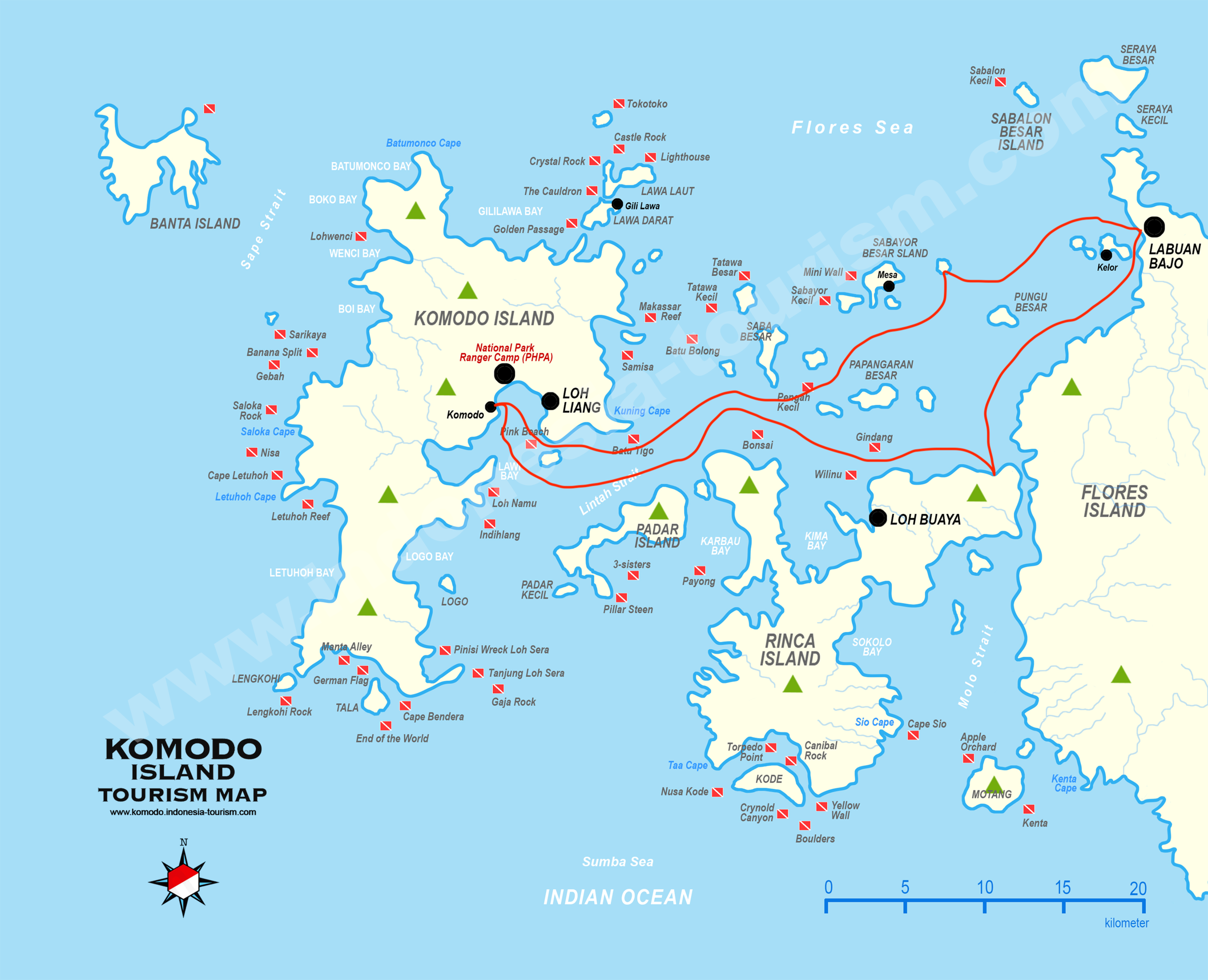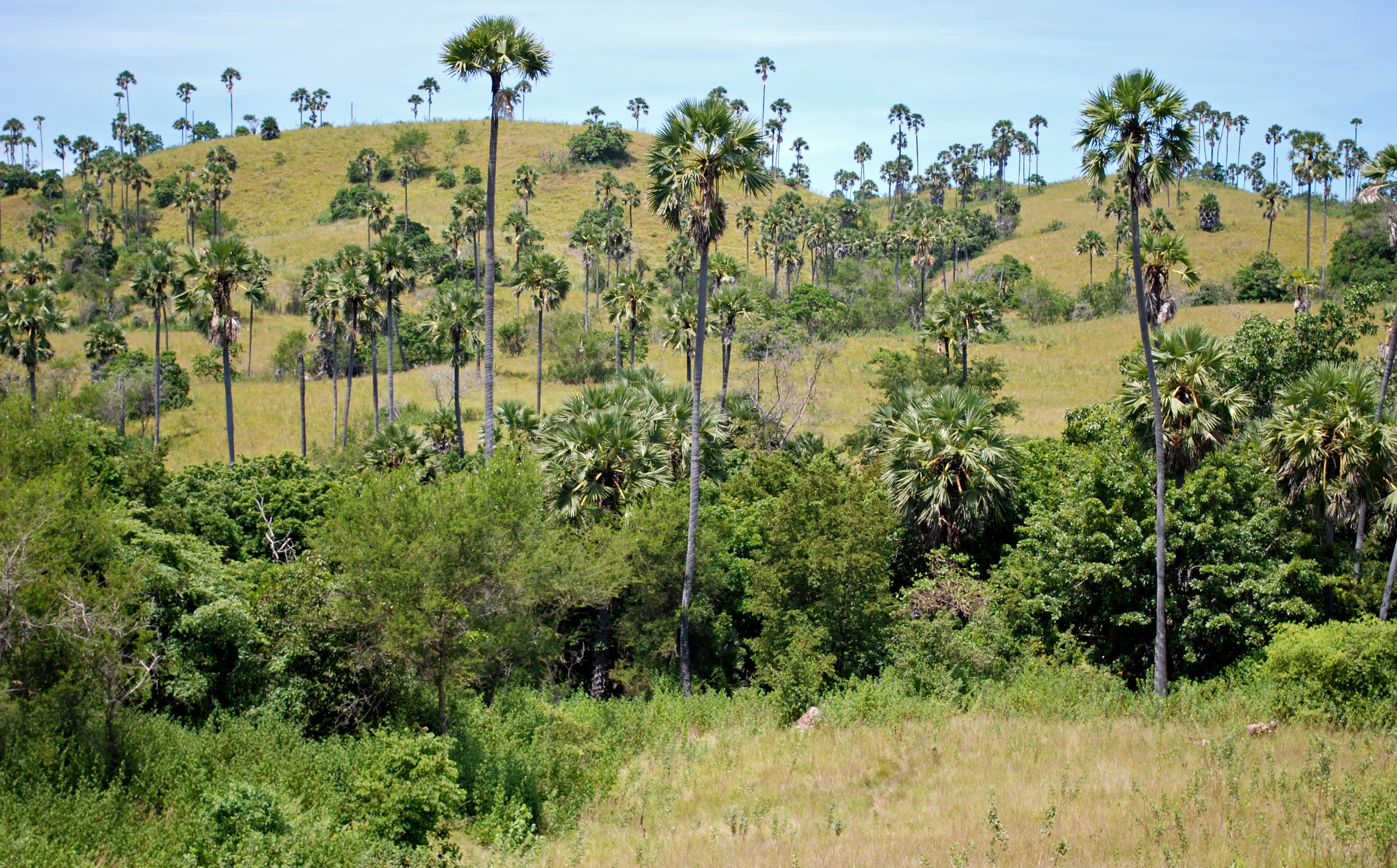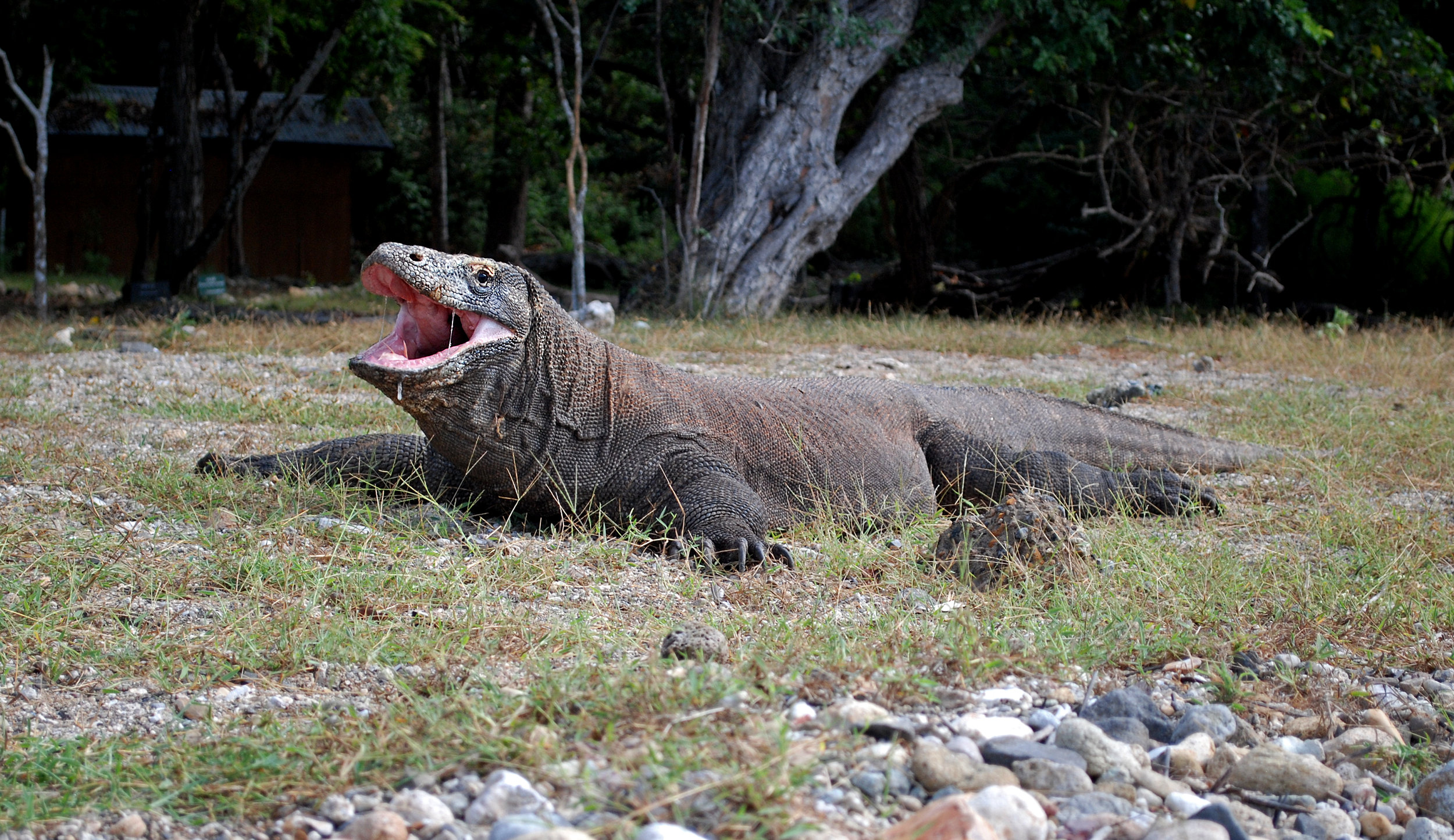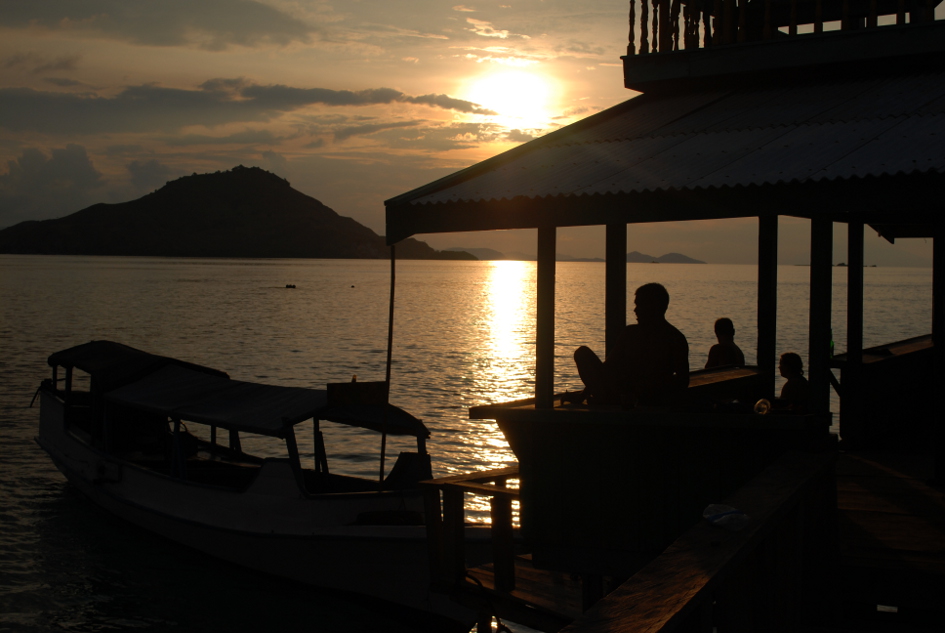29 - A Dance With Dragons (Komodo National Park, Indonesia)
Are those dragons or dump bears? CSI: Komodo. Wash that dirty, dirty mouth. Bintang, barbecue, and banana hammocks.
by Mr. Nos T. O’maniac
WE SET SAIL (FIGURATIVELY) IN THE MORNING with four souls aboard (I, Frederick, Captain Rudy, and his nephew). This was a nice interlude, a stress-free voyage into the pages of National Geographic. No motorcycle to navigate. No chickens to evade. Sit back, enjoy the ride. Our vessel had plenty of room to stretch out, and the galley was well-stocked. Fish, rice, eggs, shrimp crackers, cap cai, coffee, tea, and bananas were the standard fare. Our cup ranneth over.
First stop? Rinca Island (pronounced Rin-cha), Komodo’s little brother, one of five places you find dragons in the wild. It was here National Geographic ran into unvarnished reality. Rinca Village is not, (How can I put this delicately?), endowed aesthetically. I can only assume tourists are brought there because they’re guaranteed dragons. Therein lies the rub. Its greatest asset is its greatest liability. Ten lizards lounged around the ranger camp like stay dogs in the sun. It was, well, odd. Komodo dragons are solitary creatures for the most part, but they will congregate for chow and sexy time. They can smell food. They can smell garbage. We were told the giant hairless house cats relaxing beneath a hut were never fed. I, too, can smell garbage and wondered if this were the case. No scraps to the beasts? Ya sure? Easy access to Smaug and Puff equals cash money. At the time, I gave nary two shits. It was hard not to be enthralled with the mutant geckos, and there was no other way to get that close. (More on that below.) On our nature trot outside the village, we saw zero Godzillas. Not a surprise considering the village huddle? (Or is it? Population on Rinca: 1300.) Why buy the cow when you can eat the fucker for free?…Allegedly. I’ll grant the park service the benefit of the doubt on this, but suspicions remain. Feeding dragons would be a huge safety fail. Danger, danger, danger. And when shit goes bad, it really goes bad.
There have been numerous attacks through the years. (See articles below). A month before our arrival, a fisherman was killed and others wounded in an unprovoked assault. Dragons have been known to spice up their diet when watering holes dry up. No water, no prey. Two months earlier, a ranger in the very station where we stood experienced the dragon’s wrath. Allegedly, the cleaning crew left the door to the stilted hut open, so one ascended (probably looking for a snack). When the Ranger Maen sat at his desk and glanced below, he received the ultimate peek-a-boo surprise. Panic (on-duty ranger’s words, not mine) lead to a nasty mauling (leg and forearm). Chaos reigned. After flipping the desk, the victim climbed atop a cabinet and waited for rescue. A colleague arrived with a “dragon” staff (see left), cut especially for the purpose, and brought the monster to heel. Evicted! In the meantime other dragons moved in, enticed by the smell of blood. The ranger survived and was shuttled to Flores and then on to the more modern hospital in Bali.
The matter-of-fact nonchalance retelling made me suspect I was told a whopper aimed at gullible foreigners. The blood spattered on the wall above the cabinet felt like a prop. I mean, why not wash it off? Also, there were three large open windows in the office. Escape wasn’t just possible, it seemed laughably easy. Well, my suspicions were misplaced. Shit went down, per international headlines. Blood was real. Panic barred easy window retreat as did encroaching leviathans. This explained his inability to use one of four obvious exits (including the door).
The Most Infamous Komodo Dragon Attacks of the Past 10 Years
An 8-year old boy; a group of stranded divers; a celebrity’s husband: Just a few of the recent victims of Komodo dragon attacks
By Rachel Nuwer
SMITHSONIAN.COM
JANUARY 24, 2013
Mr. Safina, a local guide working at Komodo National Park, took a particular relish in describing the way a Komodo dragon’s strong jaws can snap a man’s leg in two. He’d lived on Rinca – a speck of land off Indonesia’s Flores Island…READ MORE
The Myth of the Komodo Dragon’s Dirty Mouth
BY ED YONG
In 1969, an American biologist named Walter Auffenberg moved to the Indonesia island of Komodo to study its most famous resident—the Komodo dragon. This huge lizard—the largest in the world—grows to lengths of 3 metres, and can take down large prey like deer and water buffalo. Auffenberg watched the dragons for a year and eventually published a book on their behaviour in 1981. It won him an award. It also enshrined a myth that took almost three decades to refute, and is still prevalent today.
Auffenberg noticed that when large…READ MORE
Shut that dirty mouth! Researchers once believed mouth bacteria accounted for a Komodo dragon’s deadly bite. Lucky enough to survive the initial attack? Well, infection would finish the job. Dragons are patient. They’ll wait for a deer, buffalo, monkey, or human to succumb. They’ve got spare time. But this is not so. Venom, not somewhat innocuous bacteria, is the true culprit. The toxin lowers blood pressure, induces shock, and prevents clotting. Tomato. Tomatoe. The result is the same without treatment. You don’t want none.
Hindsight tainted my Rinca experience, but only slightly. I must say a visit to Luh Buaya, southeast of Rinca village, might (emphasize on might) feel more “authentic”, whatever the hell that means. Then again, resorts nearby probably draw dragons from the bush as well. Conclusion: Potato. Potatoe. It’s unlikely you’ll fulfill your Planet Earth fantasy, but it’s not a deal breaker.
Scene of the attack. Nothing says “Welcome to Rinca!” quite like blood spatter.
The next morning it was off to Komodo Island. Same deal. Puff the Magic Dragon lives by the sea, drawn by the aroma of food and pussy (or schlong, as it were.) I can’t imagine getting used to these things strolling the neighborhood, but the locals are completely nonplussed. Our obligatory nature hike above Komodo village did yield two sightings. However, our guide wouldn’t allow close contact, so pictures were difficult, made more so by high-contrast light and shadow. There was a disconnect here. Urban dragons were fine. Feel free to frolic in their midst, but their dangerous “wild” cousins were a no-go. I think it’s safe to say the fuckers work shifts in town. Why, suddenly, did they become such liabilities in hill country? Dunno. Yes, dragons, though lethargic in appearance, can manage short speed bursts (up to 11 mph) if motivated, but that same logic applied in town, right? I assume? Then again, with approximately seventeen hundred dragons on Komodo, I suppose it’s possible there’s a temperamental difference between “townies” and “rednecks”. What happens in the village, stays in the village, but it’s jungle rules in the shit, ya heard!
I wasn’t interested in dry-humping the leathery bastards… much. Just wanted a closer look. What about researchers and journalists? I perceived minimal risk, confident in my minder’s knowledge and abilities (dragon staff in hand), but it was not to be. We were forced to admire from afar. I have to admit (begrudgingly) it makes sense on some level. Imagine the public relations nightmare if Johnny Tourist and his wife were mauled. It’d be a “heads rolling, shit-on-fan” scenario.
But all was not lost. Eight monsters trolled the beach in search of… Love? Cheeseburgers? Meaning? My “this feels like an open-air zoo” complaints aside, it was a fantastic experience, and I treasured my time with Puff and Company.
We spent the rest of day two and day three cruising park waters. As I mentioned above, we went with the three-day tour, as opposed to two. Why? We wanted to see and do more. Though we thought we made this clear, Captain Rudy seemed dead set on stretching the two-day itinerary into three by spending more time in each spot. Our cajoling efforts, expressed in lengthy and laborious conversations via mutilated Indonesian, were moderately successful. Still, in the end, it didn’t matter much. It’s true the third day was a bit of a wash, but it was nice being out on the water, taking it easy. I guess we were “victims” of the nonthinking-outside-box syndrome discussed in earlier posts. No mal intent, just miscommunication exacerbated by a language barrier. And there was another issue. Captain Rudy’s map-reading skills were less than stellar, so our efforts at pointing and saying, “Let’s go here”, fell on deaf ears. But don’t get me wrong, he was a kind soul and did much to ensure our satisfaction.
On the last night, we docked at Kanawa, a tiny island with snorkeling opportunities and a few overpriced bungalows for rent. I can’t speak for the present tense, but back then it was one hell of a relaxing place. We split our time between fishing off the dock and sipping Bintang, Indonesian beer. When supremely motivated, we did both simultaneously. At night we enjoyed barbecued fish and squid along with the company of two Russian women, the island’s only other foreign occupants. It was their guide fishing in his purple banana hammock. (See below.) Somehow, that just felt right. I’d love to say we found the romantic island interlude we’d been hoping for, but I’d be lying. One candidate was ill while the other, though personable, was on the middle tier of high maintenance. I distinctly remember her screaming for more canned milk or some shit. She didn’t bestill either of our hearts. The evening concluded with a fire and more beers in the sand. Romantic foil aside, there are worse ways to spend your time.
*Drone footage courtesy of Agnya Paramarta.
*Drone footage courtesy of Suwandi Chandra Photography.





































